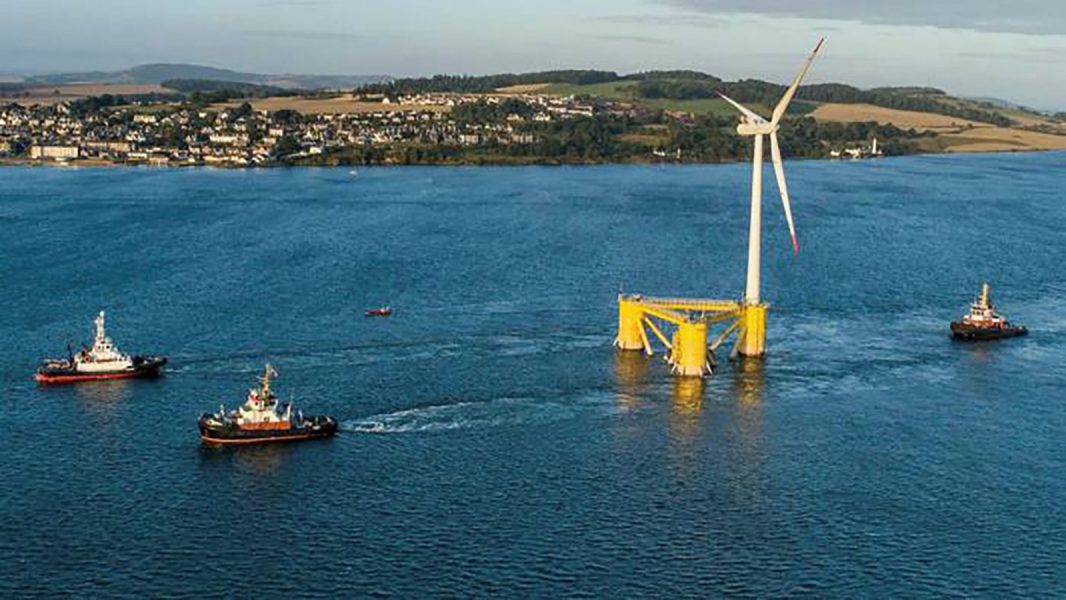In the past, Northern Ireland’s coastline has been deemed not suitable for off-shore wind.
A government report sighted the “visual impact” of potential sites based within 13km of the shore as a “significant issue”. The same report stated that offshore wind may yet have potential if “things like floating wind platforms come on stream.” Encouragingly, we are now seeing the beginnings of this movement.
Offshore wind represents the biggest opportunity for generating massive quantities of power for electricity grids. This is because winds are stronger and steadier at sea, delivering a higher power per unit area than onshore. Currently, the majority of turbines are located in shallow water, around 25-30m deep where everything can be bolted to the sea bed. As such there is currently an increasing drive to develop wind turbines that can be towed into the deep ocean where winds are even stronger and more consistent. The only problem is that open ocean waters are too deep for a tower to be extended and bolted to the bottom, hence the introduction of floating wind turbines.
The first ever offshore wind farm was developed at Vinderby in Denmark in 1991. It had a power generating capacity of 5 megawatts, providing for the annual electricity consumption of just over 2000 households. The offshore win market has grown strongly since, there are now 162 offshore wind farms around the world with a combined generating capacity of nearly 33 gigawatts, more than 6000 times the size of the Danish installation. Just last year another 15 offshore wind farms went into operation with a combined capacity of 5.2 million gigawatts. Clearly, the technology is now mature and there are 40 years of industry knowledge bringing unprecedented efficiencies and economies of scale.
Why risk it?
If offshore is doing so well in its current format, why should the industry risk pushing out into deeper waters? There are several reasons for this, firstly, in Europe wind farm developers are rapidly consuming the low hanging fruit of easily accessible near shore shallow water locations. These can be developed with minimal objection from fishing fleets, conservation groups and coastal residents. The diminishing number of these locations means that going out to sea is becoming an increasingly urgent consideration. Installing turbines in the open sea also presents fewer risks to wildlife. According to Krag Peterson, wildlife ecologist at Aarhus University in Denmark, birdlife often collides with the large blades of offshore rigs. The low density of deep sea arrays and fact that bird flights are more thinly distributed here means that the potential impact on the population is greatly reduced.
Highwind Project & Kincardine
An example floating wind turbine project has been tested on the north coast of Scotland. Five turbines each 174 meters tall have formed a floating deep water demonstration farm since 2017. Turbines sit in water more than 90 meters deep in buoyant concrete and steel keels that enable them to stand up in water like a buoy. The cylindrical bases of the turbines weigh 1000 tonnes and are held in place with three taut mooring cables attached to anchors which lie on the sea floor. Each cable has a sixty ton weight hanging from its mid point to provide additional tension. So far, the highwind demo has functioned well in the harsh conditions experienced, including 100 mph winds and 8 meter high waves.
Following on from this example, the world’s largest floating wind farm is expected to be fully operational in early 2022 just off the coast of Aberdeen. This consists of six turbines, the largest machines ever to have been installed on floating platforms and will have a generating capacity of 50 megawatts, enough power to run 60000 homes.
Negatives
There are some concerns that the high cost of floating offshore turbines will not come down enough to rival other clean energy technologies. Currently the electricity they generate is often twice as expensive as near shore and three times that of land based. Maritime engineering can also carry high expense in deploying and maintaining projects and operational life spans can be shorter to due to the corrosive nature of the marine environment.
Positives
The costs of onshore and near shore projects have continuously dropped as efficiency and economy of scale has improved over time, these trends are likely to be same for floating wind turbines. While some of the mechanical details are being tweaked, the basic technology is sound. The oil and gas industry has been using similar marine know how for decades on their floating platforms in some of the harshest marine environments on earth.
Future progress will require backing from governments and corporate investors. As Frank Adam, expert on wind energy tech at Rostock University pointed out in a BBC future planet interview,” It is easy to produce one or half a dozen floating turbines but 10,20 or 100 is another story. This requires supply chains, shipyards and ports that can handle such enormous structures and factories for serial fabrication.” Even this challenge is an opportunity for the redevelopment of coastal communities. This can already be seen in Orsted’s community benefit funds which have awarded over£4 million pounds to more than 350 projectsin various categories on the East and West coast of the UK from the arts, community activities and services, education and skills, nature conservation parks and open spaces to play facilities, sport and more. These communities are home to their offices, which are helping to regenerate the surrounding area. An example being the East Coast Hub in Grimsby, a state-of-the-art offshore wind Operations and Maintenance Centre which employs 350 members of staff, with 83% of its 350 employees living within an hour’s distance of the site.
In conclusion, despite the challenges, the potential of this kind of renewable energy generation remains an extremely exciting proposition, especially for an already world leading country in offshore wind such as the UK. The amount of energy which could be produced would be globally transformational, easily meeting the offshore wind target of 30 gigawatt by 2030. Making offshore wind the backbone of the UK’S energy system and eventually meeting the entire electricity needs of Europe, the US and Japan many times over according to the International Energy Agency.
References:
- https://orsted.co.uk/media/newsroom/news/2019/11/how-does-an-offshore-wind-farm-work
- https://orsted.co.uk/energy-solutions/offshore-wind
- https://www.bbc.co.uk/news/uk-northern-ireland-49127180
- https://pure.au.dk/portal/en/persons/anthony-david-fox(deb15e30-223d-4759-b62b-1df46dcf0d62)/publications/offshore-wind-farms-and-their-effects-on-birds(cbf2f809-e2bd-474e-83e7-b559ded37fab).html
- https://www.bbc.com/future/article/20201013-is-wind-powers-future-in-deep-water


